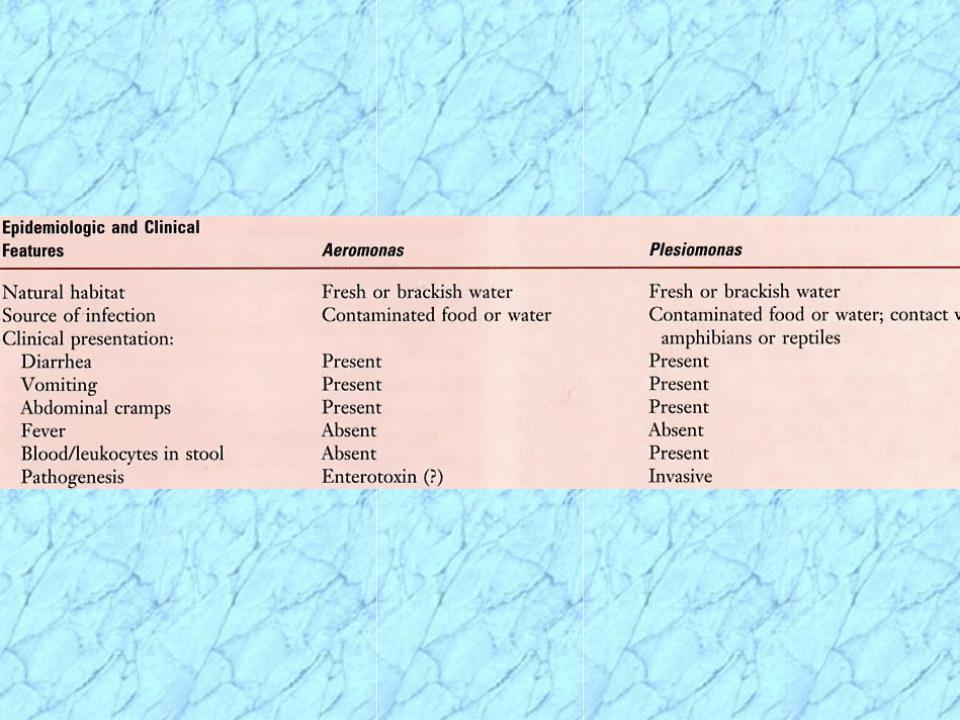
- •Vibrio, Aeromonas
- •General Characteristics of Vibrio,
- •Morphology & Physiology of Vibrio
- •Vibrio spp. (Family Vibrionaceae)
- •Epidemiology of Vibrio spp.
- •Taxonomy of Vibrio cholerae
- •Epidemiology of Vibrio cholerae
- •Recent Cholera Pandemics
- •Pathogenesis of V.cholerae
- •Pathogenesis of V.cholerae (cont.)
- •Treatment & Prevention of V. cholerae
- •Virulence Factors Associated with Vibrio cholerae O1 and O139
- •Two Broad Classes of Bacterial Exotoxins
- •Cholera Toxin (A2-5B)(Vibrio cholerae)
- •Mechanism 1
- •Mechanism of Action of Cholera Toxin
- •Heparin-binding epidermal growth factor on heart & nerve surfaces
- •Summary of Vibrio
- •Summary of Vibrio vulnificus Infections
- •Virulence Factors Associated with Non-cholerae Vibrios
- •Laboratory Identification of Vibrios
- •Characteristics and Epidemiology of
- •Clinical Syndromes of Aeromonas
- •Afimbriated
- •Fimbriated
- •Characteristics of Plesiomonas
- •Characteristics of Aeromonas and
- •REVIEW
- •Vibrio spp. (Family Vibrionaceae)
- •Epidemiology of Vibrio spp.
- •Taxonomy of Vibrio cholerae
- •Epidemiology of Vibrio cholerae
- •Summary of Vibrio cholerae Infections
- •Summary of Vibrio cholerae Infections (cont.)
- •Pathogenesis of V.cholerae (cont.)
- •Virulence Factors Associated with Vibrio cholerae O1 and O139
- •Mechanism of Action of Cholera Toxin
- •Summary of Vibrio
- •Summary of Vibrio vulnificus Infections
- •Virulence Factors Associated with Non-cholerae Vibrios
- •Characteristics and Epidemiology of
- •Clinical Syndromes of Aeromonas
- •Characteristics of Plesiomonas
- •Characteristics of Aeromonas and

Summary of Vibrio
parahaemolyticus
Infections
REVIEW

Summary of Vibrio vulnificus Infections
REVIEW

Virulence Factors Associated with Non-cholerae Vibrios
(Kanagawa positive)
REVIEW


Characteristics and Epidemiology of
Aeromonas (Family Aeromonadaceae)
Gram-negative facultatively anaerobic bacillus resembling members of the Enterobacteriaceae
Motile species have single polar flagellum
(nonmotile species apparently not associated with human disease)
16 phenospecies: Most significant human pathogens A. hydrophila, A. caviae, A. veronii biovar sobria
Ubiquitous in fresh and brackish water
Acquired by ingestion of or exposure to contaminated water or food
REVIEW

Clinical Syndromes of Aeromonas
Associated with gastrointestinal disease
Chronic diarrhea in adults
Self-limited acute, severe disease in children resembling shigellosis with blood and leukocytes in the stool
3% carriage rate
Wound infections
Opportunistic systemic disease in immunocompromised
Putative virulence factors include: endotoxin; hemolysins; eneterotoxin; proteases; siderophores;
adhesins
REVIEW

Characteristics of Plesiomonas
Formerly Plesiomonadaceae
Closely related to Proteus & now classified as
Enterobacteriaceae despite differences:
Oxidase positive
Multiple polar flagella (lophotrichous)
Single species: Plesiomonas shigelloides
Isolated from aquatic environment (fresh or estuarine)
Acquired by ingestion of or exposure to contaminated water or seafood or by exposure to amphibians or reptiles
Self-limited gastroenteritis: secretory, colitis or
chronic forms extra-intestinal infections REVIEW
Variety of uncommon

Characteristics of Aeromonas and
Plesiomonas Gastroenteritis
REVIEW

